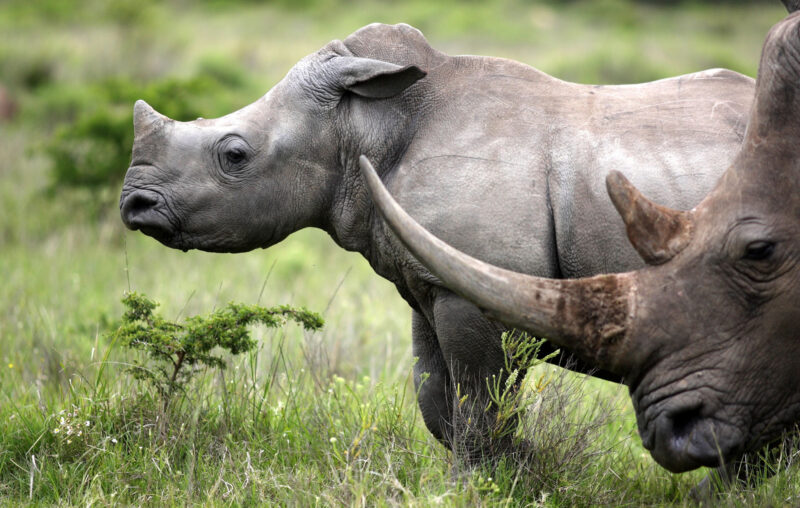Markets Aid Rhino Survival

Herd sizes continue to dwindle as poachers relentlessly harvest rhinoceros horns to satisfy an insatiable demand for everything from knife handles to alleged health remedies of all kinds. Rhino horns sell for more than their equivalent weights of gold, diamonds, or cocaine. Rhinos also bring millions of dollars in annual tourism revenue into developing countries like Namibia and Zimbabwe, and play an important part in African ecosystems because of their grazing behavior. Perhaps somewhat counterintuitively, rhinos’ consumption of over fifty kilograms of vegetation every day makes grazing lands for other grass-eaters like zebras more accessible and productive, and reduces the intensity of wildfires. Somewhat humorously, rhinos provide environmental value to other members of the animal kingdom by playing and bathing in mud puddles, since doing so keeps existing waterholes open and creates new ones. These and other reasons warrant rhino conservation. To maintain and increase rhino numbers, many organizations support universal bans on rhino hunting and possession of their horns, but could other approaches prove superior?
Around 18,000 white rhinos live in protected areas in Africa. Among them are the only two remaining female rhinos of the northern variety, making their extinction imminent. Poaching remains the top threat to all varieties of rhinos worldwide. Legalized hunting on a limited scale would reduce the poaching incentive, and using substitute horn materials to increase the supply would reduce prices even further.
As with other at-risk populations such as elephants and gorillas, allowing local African communities to establish property rights over rhino herds can turn poachers into protectors and aid the rhino herd replenishment. Since abundance and extinction concern the supply of an animal species, prudence warrants focusing energies there. Conservationists have explored creative approaches to augment the supply of illicit rhino goods, such as creating synthetic horns out of horse hair. We should, indeed, continue pursuing efforts to decrease the demand for rhino products that generate wanton killings just for their horns. For some animals, however, a supply-side approach promises greater effectiveness.
Direct herd management, while promising more control than emotional appeals to reducing demand, must start by keeping track of the number and location of the animals. Satellite tracking devices have worked for both migratory whales and elephants. Community-oriented approaches for smaller nonmigratory populations have also worked well, and might be preferable for the white rhino. A system establishing property rights and placing local villages in charge of protecting herds, and selling strategically limited hunting rights, holds more promise for increasing herd sizes than demand-management can bring to bear. Such approaches have turned poachers into protectors in nature preserves like the Periyar Tiger Reserve in India and the Zambezi River Delta in Mozambique. The doubling of the Periyar tiger population between 2002 and 2020, and the growth of other species in the Zambezi River Delta, demonstrate the viability of conservation approaches focused on establishing property rights and promoting economic development.
Anderson and Leal argue that a free-market approach establishing property rights and aligning people’s self-interest with better resource stewardship works best to preserve environmental resources. The near-threatened status of the white rhino calls for innovation in preserving the species while leaving room for experimentation. Creating localized systems that offer limited hunting permits incentivizes local communities to maintain, and help grow, nearby rhino and other wildlife populations in multiple ways. The Proceedings of the National Academy of Sciences includes studies indicating that as wealth increases in isolated communities, the hunting of bushmeat (which broadly refers to African wildlife) for food decreases. This secondary effect further promotes biodiversity and food chain stability in the animal kingdom.
Pushback from animal rights groups that condemn the legalization, however limited, of hunting rhinos for their horns is one of the most significant obstacles to exploring free-market approaches to wildlife management. Activist groups such as the World Wildlife Fund were quick to condemn South Africa’s 2017 decision to legalize the sale of rhino horns. To many people, strategies involving establishing legal markets and permits for rhino hunting are unpalatable and present a moral problem. This situation parallels the ethical morass of the traditional trolley problem, where someone faces choosing between the status quo, knowing that many lives will be lost, and pulling a lever to switch the trolley to a different track, knowingly causing the loss of an otherwise safe life in order to save many lives.
Do the benefits of establishing limited, village-regulated rhino hunting rights (to reduce rhino deaths and promote the prosperity of the species) offset the loss of the specific rhinos harvested in the process? Implementing this strategy places a metaphorical lever into the scenario and forces us to consider whether we view as equivalent the moral weights of action and of inaction.
White rhinos serve as ideal candidates for a program establishing village property rights over a herd animal, similar to other domesticated herd animals. This approach promotes the survival of the rhinos and the prosperity of struggling villages. Namibia currently operates a similar program, in which the government sells permits for the hunting of critically endangered black rhinos. The government only sells licenses to hunt old bulls, benefiting the herd by increasing the population growth rate since old bulls are usually the most violent, killing younger bulls and jeopardizing the herd’s integrity through inbreeding. A drawback of the program is that the government owns the rights to the rhinos, not the local people closest to the herds. The money from the licenses supposedly goes towards national park upkeep and rhino conservation, but many are skeptical. Local ownership could better support both conservation and local prosperity.
Thousands of animal rights activists, including the Humane Society International, staunchly oppose “killing for conservation.” HSI’s Director of Wildlife maintains that allowing trophy hunting “should never be used” for conservation efforts because it “removes [those animals] from critically endangered species populations.” Since incentive structures such as hunting bans have ultimately failed rhino populations in general, recall the trolley problem.
Is it ethical to sanction the killing of some specific white rhinos to promote the prosperity of the greater population? Is there a moral difference between sanctioning the killing of a white rhino and that of any other animal? Does the near-threatened status of the white rhino really make it different from domesticated animals? Ultimately, we have to ask, what works to increase herd sizes?
For economic, environmental, and moral reasons, many organizations and individuals support efforts to increase rhino populations, but top-down government approaches to fighting poaching and saving the rhino have been largely ineffective. Exploring a free market approach to rhino preservation through village-managed property rights presents a clear option, similar to successful programs for elephants and tigers. Exploring market solutions beyond village-managed hunting permits, such as flooding the market with synthetic rhino horns made out of horse hair, also has merit. If we ask the rhinos, they might well prefer giving free-market approaches a shot.












